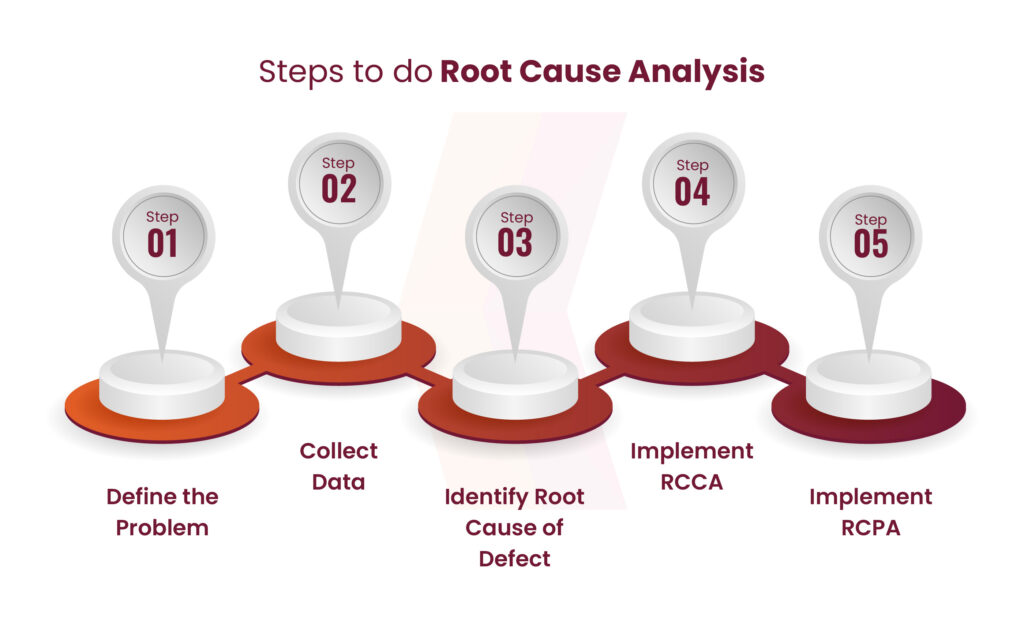
When challenges surface within a company, numerous hassle-fixing processes can be adopted. Root Cause Analysis (RCA) stands out as a strong approach for pinpointing and resolving business problems. By figuring out underlying inefficiencies or flaws and enforcing corrective measures, RCA objectives to prevent the recurrence of issues.
RCA holds great fees for companies throughout various industries, including oil and gasoline, engineering, healthcare, aviation, and IT operations. It operates in the opposite, striving to isolate reputedly minor mistakes that can cause or exacerbate big issues. In this blog, we will talk about what it is and what are the steps to carry out RCA.
As the name suggests, root cause analysis is a collection of troubleshooting techniques and tools that help teams identify the fundamental causes of their difficult circumstances. This, however, goes beyond just identifying the main issue. It also helps teams identify contributing factors, create remedial actions, and improve business processes through continuous improvement.
How to Perform Root Cause Analysis?
Since RCA encompasses a diverse array of tools, methods, and techniques, there’s no universal approach. Nevertheless, here are the fundamental steps in root cause analysis to assist you in commencing your analysis.

Defining the Problem
The initial stage of RCA involves defining the problem requiring the resolution or enhancement to be achieved. Attaining a comprehensive and detailed comprehension of the issue holds paramount importance.
Allocate sufficient time to grasp the problem or improvement objective thoroughly. Gather pertinent data and document the analysis process. Consider the following aspects:
- The overall impact of the problem on the company.
- The frequency of occurrence or the extent of inefficiency.
- The metrics currently used to evaluate the problem or process.
An operations manager might, for example, look into new product releases that are frequently delayed. The management can accurately quantify the frequency of those delays by gathering and analyzing statistics, which provides a precise portrayal of the issue. They could also explain how this challenge affects the larger commercial enterprise context. Regularly missing deadlines for releases erode customer satisfaction and consent, which has negative effects on sales.
Collect Data Regarding Defects
Obtaining detailed records and documentation related to the condition is part of the record-keeping process. This includes understanding its significance, providing evidence of its presence, figuring out how long it has persisted, and evaluating whether or not it is a common problem. Throughout this process, communication with clients and staff is crucial. Before identifying the underlying cause, a thorough analysis of the flaw or issue is necessary. This entails gathering the necessary data and evidence.
Identify Root Cause of the Defect
Finding the fundamental cause of a disorder involves determining the main factor responsible for its emergence. This entails understanding the reason for the defect’s existence and determining the main cause of its occurrence. Many tools are now available for this purpose, and selecting the right tool is essential to getting the desired results. Conducting brainstorming meetings is also essential in this way. The process of brainstorming involves working together to identify a specific issue or disease. It’s important to remember that a disorder may have multiple underlying causes, so it’s critical to identify as many as you can.
Implement Root Cause Corrective Action (RCA)
It’s essential to devise a plan to prevent the recurrence of defects. To ensure that defects do not arise again in the future, it’s necessary to enhance skills, execute tasks correctly, and adhere to proper documentation of preventive actions.
Why is Root Cause Analysis Important?
It serves as a solution to address these issues, providing sufficient motivation for its application. Hence, there are fewer defects in the final product. Below are the reasons why RCA is important.
Reduced Cost
Defects become more costly to fix later in the development process they may be discovered. In addition, customers may lose faith in the product if a sickness is not treated and continues until the very end, which would result in a loss of revenue for the agency.
Identification of Failure
Root Cause Analysis (RCA) is particularly helpful for organizations that believe they have strong quality assurance (QA) and improvement strategies in place yet continue to encounter errors. There is a breakdown, but it is crucial to identify what, why, and where it happens. Rather than concentrating only on the obvious (direct) purpose, RCA helps answer these questions and reveal the true (root) cause of the issue.
Improvement in Safety and Reliability
Given its capacity to decrease future defect occurrences, root cause analysis proves particularly advantageous for firms operating in quality-critical industries where product reliability and safety are paramount concerns.
Book a Free Consultation with our Cyber Security Experts

How Kratikal Helps Organizations in Root Cause Analysis?
Choosing us for Root Cause Analysis (RCA) ensures comprehensive and effective incident resolution. Here’s why:
Immediate Action
The security team at Kratikal prioritizes halting ongoing attacks swiftly. Our team implements immediate measures to mitigate the incident’s impact, preventing further damage.
Thorough Investigation
The testing team conducts a meticulous analysis of affected assets, tracing the attack’s origin and method. Understanding the attack vectors and entry points is crucial for devising robust defense strategies.
Detailed Reporting
Kratikal’s reports are exhaustive, documenting every step of the investigation process. From initial response actions to identifying Indicators of Compromise (IOCs), our reports provide clear insights into the incident’s timeline and progression.
Evidence and Proof
The team furnishes concrete evidence and proof related to the attack, ensuring transparency and credibility in our findings. This evidence aids in understanding the severity of the incident and justifies the recommended actions.
Comprehensive Recommendations
Beyond merely identifying the root cause, we offer comprehensive recommendations for future prevention and mitigation. These recommendations are tailored to address the specific vulnerabilities and weaknesses exposed by the incident.
Description: Screenshot showing malware in the background
By choosing Kratikal, a CERT-In empanelled auditor for RCA, you can trust in our expertise to deliver thorough, actionable insights that empower your organization to bolster its security posture and minimize the risk of future incidents.
FAQ
- Q1: Which is the best method for root cause analysis?
Ans: The Five Why’s method is one of the simplest and most used methods for this analysis. It entails posing the question “Why?” at least five times until the core cause of an issue or flaw is found.
- Q2: What are the root cause analysis’s limitations?
Ans: This is a valuable technique, however it is not flawless. As situations get more complicated, its usefulness decreases. For instance, even if you can identify several causes, ranking them doesn’t always assist.
The post What is Root Cause Analysis? appeared first on Kratikal Blogs.
*** This is a Security Bloggers Network syndicated blog from Kratikal Blogs authored by Shikha Dhingra. Read the original post at: https://kratikal.com/blog/what-is-root-cause-analysis/
如有侵权请联系:admin#unsafe.sh